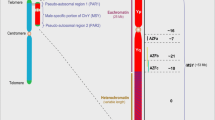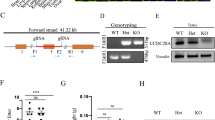Abstract
There is evidence from Y Chromosome (Chr) deletion mapping that there is a gene on the long arm of the mouse Y Chr that is needed for the normal development of the sperm head. Since mice with partial Y long arm deletions show incomplete penetrance of the sperm head defect, whereas mice with no Y long arm show complete penetrance, it has been suggested that the ‘spermiogenesis’ gene may be present in multiple copies. A Y-specific genomic DNA sequence (Y353/B) has previously been described that is present in multiple copies on the long arm of the mouse Y and identifies testis-specific transcripts. We have suggested that Y353/B could be the proposed multiple copy ‘spermiogenesis’ gene. In support of this suggestion, we show here that mice with a partial Y long arm deletion associated with a 3.5-fold increase in the frequency of abnormal sperm heads have a marked reduction in genomic Y353/B copies and a corresponding reduction in Y353/B-related transcripts. Thus, the incompletely penetrant phenotype correlates with a reduction in Y353/B-related transcription. Furthermore, by in situ hybridization with a Y353/B riboprobe to testis sections, we show that the Y353/B-related transcripts are confined to the round spermatid stage of spermiogenesis, just prior to the shaping of the sperm head. The transcripts sediment with the fraction of cytoplasmic RNA in adult testis that is loaded on polysomes, suggesting that the transcripts are actively translated.
Similar content being viewed by others
References
Bishop, C.E., Hatat, D. (1987). Molecular cloning and sequence analysis of a mouse Y chromosome RNA transcript expressed in the testis. Nucleic Acids Res. 15, 2959–2969.
Bishop, C.E., Boursot, P., Baron, B., Bonhomme, F., Hatat, D. (1985). Most classical Mus musculus domesticus laboratory mouse strains carry a Mus musculus musculus Y chromosome. Nature 315, 70–72.
Burgoyne, P.S. (1987). The role of the mammalian Y chromosome in spermatogenesis. Development 101, 133–141.
Burgoyne, P.S. (1991). Y chromosome function in mammalian development. In Advances in Developmental Biology, P.M. Wassarman, ed. (Greenwich, Connecticut: JAI Press, Inc.), pp. 1–29.
Burgoyne, P.S. (1993). Deletion mapping the functions of the mouse Y chromosome. In Sex Chromosomes and Sex-Determining Genes, K.C. Reed, J.A.M. Graves, eds. (Chur, Switzerland: Harwood Academic Publishers), pp. 357–372.
Burgoyne, P.S., Levy, E.R., McLaren, A. (1986). Spermatogenic failure in male mice lacking H-Y antigen. Nature 320, 170–172.
Burgoyne, P.S., Mahadevaiah, S.K., Sutcliffe, M.J., Palmer, S.J. (1992). Fertility in mice requires X-Y pairing and a Y-chromosomal “spermiogenesis” gene mapping to the long arm. Cell 71, 391–398.
Capel, B., Swain, A., Nicolis, S., Hacker, A., Walter, M., Koopman, P., Goodfellow, P., Lovell-Badge, R. (1993). Circular transcripts of the testis-determining gene Sry in adult mouse testis. Cell 73, 1019–1030.
Chomczynski, P., Sacchi, N. (1987). Single-step method of RNA isolation by acid guanidium thiocyanate-phenol-chloroform extraction. Anal. Biochem. 162, 156–159
Cox, K.H., Deleon, D.V., Angerer, L.M., Angerer, R.C. (1984). Detection of mRNAs in sea urchin embryos by in situ hybridization using asymmetric RNA probes. Dev. Biol. 101, 485–502.
Davis, R.M. (1981). Localization of male determining factors in man: a thorough review of structural anomalies of the Y chromosome. J. Med. Genet. 18, 161–195.
Eicher, E.M., Phillips, S.J., Washburn, L.L. (1983). The use of molecular probes and chromosomal rearrangements to partition the mouse Y chromosome into functional regions. In Recombinant DNA and Medical Genetics, A. Messer, I.H. Porter, eds. (New York: Academic Press), pp. 57–71.
Eicher, E.M., Hale, D.W., Hunt, P.A., Lee, B.K., Tucker, P.K., King, T.R., Eppig, J.T., Washburn, L.L. (1991). The mouse Y* chromosome involves a complex rearrangement, including interstitial positioning of the pseudoautosomal region. Cytogenet. Cell Genet. 57, 221–230.
Evans, E.P., Breckon, G., Ford, C.E. (1964). An air-drying method for meiotic preparations for mammalain testes. Cytogenetics 3, 289–294.
Feinberg, A.P., Vogelstein, B. (1983). A technique for radiolabeling DNA restriction endonuclease fragments to high specific activity. Anal. Biochem. 132, 6–13.
Gubbay, J., Koopman, P., Collignon, J., Burgoyne, P., Lovell-Badge, R. (1990). Normal structure and expression of Zfy genes in XY female mice mutant in Tdy. Development 109, 647–653.
Hancock, J.L. (1951). A staining technique for the study of temperature shock in semen. Nature 167, 323.
Hogan, B.L.M., Constantini, F., Lacy, E. (1986). Manipulating the Mouse Embryo: A Laboratory Manual, (Cold Spring Harbor, N.Y.: Cold Spring Harbor Laboratory Press).
Hurst, L.D. (1992). Is Stellate a relict meiotic driver? Genetics 130, 229–230.
Hurst, L.D., Pomiankowski, A. (1991): Causes of sex ratio bias may account for unisexual sterility in hybrids: a new explanation of Haldane's rule and related phenomena. Genetics 128, 841–858.
Ingham, P.W., Fujimoto, H., Witt, M.P., Verga, V., Erickson, R.P. (1989). A genomic clone of Zfy-1 from a YDOM mouse strain detects post-meiotic gene expression of Zfy in testes. Biochem. Biophys. Res. Commun. 165, 1286–1291.
Kedes, L.H. (1979): Histone genes and histone messengers. Annu. Rev. Biochem. 48, 837–870.
Koopman, P., Gubbay, J., Collignon, J., Lovell-Badge, R. (1989). Zfy gene expression patterns are not compatible with a primary role in mouse sex determination. Nature 342, 940–942.
Krzanowska, H. (1969). Factor responsible for spermatozoan head abnormality located on the Y chromosome in mouse. Genet. Res. 13, 17–24.
Krzanowska, H. (1976). Inheritance of sperm head abnormality types in mice: the role of the Y chromosome. Genet. Res. 28, 189–198.
Krzanowska, H. (1986). Interstrain competition amongst mouse spermatozoa inseminated in various proportions, as affected by the genotype of the Y chromosome. J. Reprod. Fertil. 77, 265–270.
Long, E.O., Dawid, I.B. (1980). Repeated genes in eukaryotes. Annu. Rev. Biochem. 49, 727–764.
Ma, K., Inglis, J.D., Sharkey, A., Bickmore, W.A., Hill, R.E., Prosser, E.J., Speed, R.M., Thomson, E.J., Jobling, M., Taylor, K., Wolfe, J., Cooke, H.J., Hargreave, T.B., Chandley, A.C. (1993). A Y chromosome gene family with RNA-binding protein homology: candidates for the azoospermia factor AZF controlling human spermatogenesis. Cell 75, 1–20.
Mardon, G., Page, D.C. (1989). The sex-determining region of the mouse Y chromosome encodes a protein with a highly acidic domain and 13 zinc fingers. Cell 56, 765–770.
Monesi, V. (1965). Synthetic activities during spermatogenesis in the mouse. Exp. Cell Res. 39, 197–224.
Moriwaki, K., Suh, D.-S., Styrna, J. (1988). Genetic factors affecting sperm morphology in the mouse. Mouse News Lett. 82, 138.
Nagamine, C.M.. Chan, K., Hake, L.E., Lau, Y.F. (1990). The two candidate testis-determining Y genes (Zfy-1 and Zfy-2) are differentially expressed in fetal and adult mouse tissues. Genes Dev. 4, 63–74.
Prado, V.F., Lee, C.-H., Zahed, L., Vekemans, M., Nishioka, Y. (1992). Molecular characterization of a mouse Y chromosomal repetitive sequence that detects transcripts in the testis. Cytogenet. Cell Genet. 61, 87–90.
Richler, C., Uliel, E., Kerem, B.-S., Wahrman, J. (1987). Regions of active chromatin conformation in ‘inactive’ male meiotic sex chromosomes of the mouse. Chromosoma 95, 167–170.
Singer-Sam, J., Robinson, M.O., Bellvé, A.R., Simon, M.I., Riggs, A.D. (1990). Measurement by quantitative PCR of changes in HPRT, PGK-1, PGK-2, APRT, MTase, and Zfy gene transcripts during mouse spermatogenesis. Nucleic Acids Res 18, 1255–1259.
Styrna, J., Imai, H.T., Moriwaki, K. (1991a). An increased level of sperm abnormalities in mice with a partial deletion of the Y chromosome. Genet. Res. 57, 195–199.
Styrna, J., Klag, J., Moriwaki, K. (1991b). Influence of partial deletion of the Y chromosome on mouse sperm phenotype. J. Reprod. Fertil. 92, 187–195.
Sutcliffe, M.J., Burgoyne, P.S. (1989). Analysis of the testes of H-Y negative XOSxrb mice suggests that the spermatogenesis gene (Spy) acts during the differentiation of the A spermatogonia. Development 107, 373–380.
Sutcliffe, M.J., Darling, S.M., Burgoyne, P.S. (1991). Spermatogenesis in XY, XYSxra and XOSxra mice: a quantitative analysis of spermatogenesis throughout puberty. Mol. Reprod. Dev. 30, 81–89.
Tease, C., Cattanach, B.M. (1989). Sex chromosome pairing patterns in male mice of novel Sxr genotypes. Chromosoma 97, 390–395.
Willison, K., Dudley, K., Potter, J. (1986). Molecular cloning and sequence analysis of haploid expressed genes encoding t complex polypeptide 1. Cell 44, 727–738.
Willison, K.R., Hynes, G., Davies, P., Goldsborough, A., Lewis, V.A. (1990). Expression of three t-complex genes, Tcp-1, D17Leh117c3, and D17Leh66, in murine spermatogenic cell populations. Genet. Res. 56, 193–201.
Author information
Authors and Affiliations
Additional information
P. Burgoyne at Laboratory of Developmental Genetics
Rights and permissions
About this article
Cite this article
Conway, S.J., Mahadevaiah, S.K., Darling, S.M. et al. Y353/B: a candidate multiple-copy spermiogenesis gene on the mouse Y chromosome. Mammalian Genome 5, 203–210 (1994). https://doi.org/10.1007/BF00360546
Received:
Accepted:
Issue Date:
DOI: https://doi.org/10.1007/BF00360546




